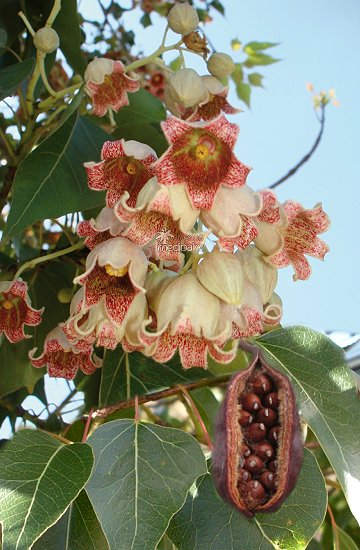
|
|
Kurrajong (Brachychiton populneus).
Leaves, flowers and fruit.
|
Kurrajong - Brachychiton populneus
Brachychiton (kurrajong, bottletree) is a genus of 31 species of trees and large shrubs, native to Australia (the centre of diversity, with 30 species), and New Guinea (one species). Fossils from New South Wales and New Zealand are estimated to be 50 million years old, corresponding to the Paleogene.
They grow to 4 – 30m tall, and some are dry-season deciduous. Several species (though not all) are pachycaul plants with a very stout stem for their overall size, used to store water during periods of drought. The leaves show intraspecific variation and generally range from entire to deeply palmately lobed with long slender leaflet-like lobes joined only right at the base. Their sizes range from 4 – 20 cm long and wide.
All species are monoecious with separate male and female flowers on the same plant. The flowers have a bell-shaped perianth consisting of a single series of fused lobes which is regarded as a calyx despite being brightly coloured in most species. The female flowers have five separate carpels that can each form a woody fruit containing several seeds. The flower colour is often variable within species. Eastern forest species drop their foliage before flowering but those of the drier regions carry the flowers while in leaf.
The name Brachychiton is derived from the Greek brachys, short, and chiton, tunic, in referring to its loose seed coats.
The Kurrajong (Brachychiton populneus) is a small to medium sized tree found naturally in Australia in a diversity of habitats from wetter coastal districts to semi-arid interiors of Victoria, New South Wales and Queensland. The extended trunk is a water storage device for survival in a warm dry climate. The bell-shaped flowers are variable in colour (pale to pink) while the leaves vary considerably in shape. The leaves are either simple and pointed, or may be 3 - 9 lobed. Saplings grow from a drought and fire resistant tap-rooted tuber.
The specific name populneus pertains to a perceived similarity to genus Populus, the Poplars. Sometimes B. populneus is also known by the names "lacebark kurrajong" and "bottle tree" (USA). However, B.discolor is also referred to as the Lacebark Kurrajong, and Bottle Tree is a term commonly applied not only to other species of Brachychiton but to members of other genera around the world.
Kurrajong comes from Dharuk garraju "fishing line", as fishing lines were made from kurrajong bark.
Kurrajong (Brachychiton populneus) is méodest size evergreen, broad domed tree of 12 to 15m in height by 12 to 15 m in crown diameter generally with a stout trunk.
Bark is green and smooth on young trees and smaller branches in upper crown, becoming dark, compacted and coarsely fissured on stout trunk to larger branches of maturing specimens.
Foliage discolourous, glossy green above and paler green below. Mostly entire but sometimes with up to 3 small pointed lobes depending on subspecies. Subspecies populneus has mostly entire leaves reminiscent of Poplar (Populus genus) and subspecies trilobus has 3, sometimes 5, narrow lobes.
Flowers, appearing in October to December, are cream to pale green bell shaped flowers with pale pink to purple flecks in the throat of the bell.
Fruit are a leathery boat shaped follicle with hairs on the seeds held within.
Drought tolerant, prefers free draining soils. Low tolerance of waterlogged sites and excessive root disturbance. Can be transplanted successfully as a smaller tree (3-4m) but presence of residual tap root can be problematic.
It is a terrific dense, broad domed tree offering cool shade suitable for use in average to larger gardens.
An ideal street tree and suitable for pruning below electrical services.
Kurrajong has multiple uses. Seeds are eaten by Aboriginal people after roasting. A popular Aboriginal food, they are also acceptable to western palates, especially when roasted. Very nutritious, containing about 18% protein, 25% fat plus high levels of zinc and magnesium. The roasted seed is used as a coffee substitute. Root - yam-like. A popular food item with the Australian Aborigines. The root of very young trees is used. The soft spongy wood was used for making shields, and the bark as a fibre. The leaves are also used as emergency fodder for drought-affected animal stock.
It has been introduced as an ornamental tree to south-western Australia, South Africa, Louisiana, California, Arizona and Mediterranean countries. In Western Australia it was observed to be invasive in disturbed areas.
Horticulturists have hybridised the Kurrajong with related Brachychiton species, including the Queensland bottle tree (B. rupestris) and Illawarra Flame Tree (B. acerifolius) to produce new garden ornamentals.
Kurrajongs are known to bloom erratically in cultivation.
Source:
http://en.wikipedia.org/wiki/Brachychiton
http://en.wikipedia.org/wiki/Brachychiton_populneus
http://treelogic.com.au/facts/brachychiton-populneus-kurrajong/
